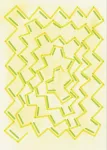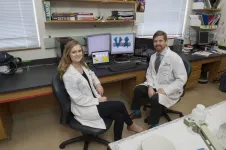(Press-News.org) Clinical research on COVID-19 has boomed in the 18 months since the disease first appeared. Countless papers have looked at the topic from almost every possible angle, including methods of detection.
For a new paper published in the journal END
Concordia researchers break down the COVID-19 diagnostic arsenal
Hamid Tali and Sana Anbuhi comb the growing pile of literature for the tools and techniques that best detect the virus
2021-06-16
ELSE PRESS RELEASES FROM THIS DATE:
How a supermassive black hole originates
2021-06-16
RIVERSIDE, Calif. -- Supermassive black holes, or SMBHs, are black holes with masses that are several million to billion times the mass of our sun. The Milky Way hosts an SMBH with mass a few million times the solar mass. Surprisingly, astrophysical observations show that SMBHs already existed when the universe was very young. For example, a billion solar mass black holes are found when the universe was just 6% of its current age, 13.7 billion years. How do these SMBHs in the early universe originate?
A team led by a theoretical physicist at the University of California, Riverside, has come up with an explanation: a massive seed black hole that the collapse of a dark matter halo could produce.
Dark matter halo is the halo of invisible matter ...
Pioneering chemistry approach could lead to more robust soft electronics
2021-06-16
RESEARCH TRIANGLE PARK, N.C. -- A new approach to studying conjugated polymers made it possible for an Army-funded research team to measure, for the first time, the individual molecules' mechanical and kinetic properties during polymerization reaction. The insights gained could lead to more flexible and robust soft electronic materials, such as health monitors and soft robotics.
Conjugated polymers are essentially clusters of molecules strung along a backbone that can conduct electrons and absorb light. This makes them a perfect fit for creating soft optoelectronics, such as wearable electronic devices; however, as flexible as they are, these polymers are difficult to study in bulk because they aggregate ...
P-glycoprotein removes Alzheimer's-associated toxin from the brain
2021-06-16
DALLAS (SMU) -- A team of SMU biological scientists has confirmed that P-glycoprotein (P-gp) has the ability to remove a toxin from the brain that is associated with Alzheimer's disease.
The finding could lead to new treatments for the disease that affects nearly 6 million Americans. It was that hope that motivated lead researchers James W. McCormick and Lauren Ammerman to pursue the research as SMU graduate students after they both lost a grandmother to the disease while at SMU.
In the Alzheimer's brain, abnormal levels of amyloid-β proteins clump together to form plaques that collect between neurons and can disrupt cell function. ...
Having a strong life purpose eases loneliness of COVID-19 isolation
2021-06-16
Why can some people weather the stress of social isolation better than others, and what implications does this have for their health? New research from the Communication Neuroscience Lab at the Annenberg School for Communication at the University of Pennsylvania found that people who felt a strong sense of purpose in life were less lonely during the COVID-19 pandemic. Did they achieve less loneliness by flouting public health guidance? No. Although lonelier people were less likely to want to follow public health guidance, people with a stronger sense of purpose also expressed more willingness to engage in social distancing, hand washing, and other ...
Study reveals recipe for even more powerful COVID-19 vaccines
2021-06-16
A new study looking at the way human cells activate the immune system in response to SARS-CoV-2 infection could open the door to even more effective and powerful vaccines against the coronavirus and its rapidly emerging variants keeping the global pandemic smoldering.
Researchers from Boston University's National Emerging Infectious Diseases Laboratories (NEIDL) and the Broad Institute of MIT and Harvard say it's the first real look at exactly what types of "red flags" the human body uses to enlist the help of T cells--killers sent out by the immune system to destroy infected cells. Until now, COVID vaccines have been focused on activating a different type of immune cell, B cells, which are responsible for creating antibodies. Developing vaccines to activate ...
Over-the-counter fungicide can disrupt hormones
2021-06-16
Steroid (sex) hormones play a central role in sexual development: They help determine how boys become boys and girls become girls. If these hormones are disrupted during fetal life, it can lead to a string of reproductive disorders at birth and later in life, including malformed genitals and decreased fertility.
Many environmental chemicals are known to disrupt the hormone system and are often referred to as endocrine disrupting chemicals. Azole fungicides constitute one group that can act as endocrine disruptors. Azoles are used to combat yeast infestations in seed and food crops, but are also used in medications for humans.
Most azoles used in medicines are tightly regulated and their use is well controlled. However, some are sold over-the-counter, for ...
Stem cells may hold a key to developing new vaccines against COVID-19
2021-06-16
Philadelphia, June 16, 2021 - The SARS-CoV-2 virus that causes COVID-19 may have the ability to reactivate dormant tuberculosis (TB). In a novel study scientists END ...
Coronary angiography video interpolation methods to reduce x-ray exposure frequency
2021-06-16
In a new publication from Cardiovascular Innovations and Applications; DOI https://doi.org/10.15212/CVIA.2021.0011, Xiao-lei Yin, Dong-xue Liang, Lu Wang, Jing Qiu, Zhi-yun Yang, Jian-zeng Dong and Zhao-yuan Ma from Tsinghua University, Beijing, China; Capital Medical University, Beijing, China and The First Affiliated Hospital of Zhengzhou University, Zhengzhou, China analyse coronary angiography video interpolation methods to reduce x-ray exposure frequency based on deep learning.
Cardiac coronary angiography is a major technique that assists physicians during interventional heart surgery. Under X-ray irradiation, the physician ...
ST-segment depression in leads I and aVL: Artifactual or pathophysiological findings?
2021-06-16
In a new publication from Cardiovascular Innovations and Applications; DOI https://doi.org/10.15212/CVIA.2021.0013, Sharen Lee, Gary Tse, Xin Wang, Adrian Baranchuk and Tong Liu from Laboratory of Cardiovascular Physiology, Hong Kong, China, Second Hospital of Tianjin Medical University, Tianjin, China and Queen's University, Kingston, Ontario, Canada consider ST-segment depression in leads I and aVL.
The 12-lead electrocardiogram (ECG) is a routinely performed test but is susceptible to misinterpretation even by experienced physicians. The authors report a case of a 72-year-old lady with no prior cardiac history presenting with atypical chest pain. Her initial electrocardiogram shows an initial ST depression followed by positive deflections leads I and aVL. ...
Pursuing safer, cheaper pharmaceuticals via electromagnetic control at the atomic level
2021-06-16
Commonplace pharmaceuticals, such as ibuprofen, can carry with them an inherent flaw in their atomic structure, which pairs the active, beneficial ingredient with a potentially ineffective -- or even toxic -- counterpart. New research could hold the key to more easily isolating the good while removing the unwanted.
Dr. Shoufeng Lan, assistant professor in the J. Mike Walker '66 Department of Mechanical Engineering at Texas A&M University, is leading a team investigating the use of electromagnetic control over the synthesis of chiral compounds at an atomic level -- a process that could lead to a plethora of practical ...
LAST 30 PRESS RELEASES:
Why nail-biting, procrastination and other self-sabotaging behaviors are rooted in survival instincts
Regional variations in mechanical properties of porcine leptomeninges
Artificial empathy in therapy and healthcare: advancements in interpersonal interaction technologies
Why some brains switch gears more efficiently than others
UVA’s Jundong Li wins ICDM’S 2025 Tao Li Award for data mining, machine learning
UVA’s low-power, high-performance computer power player Mircea Stan earns National Academy of Inventors fellowship
Not playing by the rules: USU researcher explores filamentous algae dynamics in rivers
Do our body clocks influence our risk of dementia?
Anthropologists offer new evidence of bipedalism in long-debated fossil discovery
Safer receipt paper from wood
Dosage-sensitive genes suggest no whole-genome duplications in ancestral angiosperm
First ancient human herpesvirus genomes document their deep history with humans
Why Some Bacteria Survive Antibiotics and How to Stop Them - New study reveals that bacteria can survive antibiotic treatment through two fundamentally different “shutdown modes”
UCLA study links scar healing to dangerous placenta condition
CHANGE-seq-BE finds off-target changes in the genome from base editors
The Journal of Nuclear Medicine Ahead-of-Print Tip Sheet: January 2, 2026
Delayed or absent first dose of measles, mumps, and rubella vaccination
Trends in US preterm birth rates by household income and race and ethnicity
Study identifies potential biomarker linked to progression and brain inflammation in multiple sclerosis
Many mothers in Norway do not show up for postnatal check-ups
Researchers want to find out why quick clay is so unstable
Superradiant spins show teamwork at the quantum scale
Cleveland Clinic Research links tumor bacteria to immunotherapy resistance in head and neck cancer
First Editorial of 2026: Resisting AI slop
Joint ground- and space-based observations reveal Saturn-mass rogue planet
Inheritable genetic variant offers protection against blood cancer risk and progression
Pigs settled Pacific islands alongside early human voyagers
A Coral reef’s daily pulse reshapes microbes in surrounding waters
EAST Tokamak experiments exceed plasma density limit, offering new approach to fusion ignition
Groundbreaking discovery reveals Africa’s oldest cremation pyre and complex ritual practices
[Press-News.org] Concordia researchers break down the COVID-19 diagnostic arsenalHamid Tali and Sana Anbuhi comb the growing pile of literature for the tools and techniques that best detect the virus





